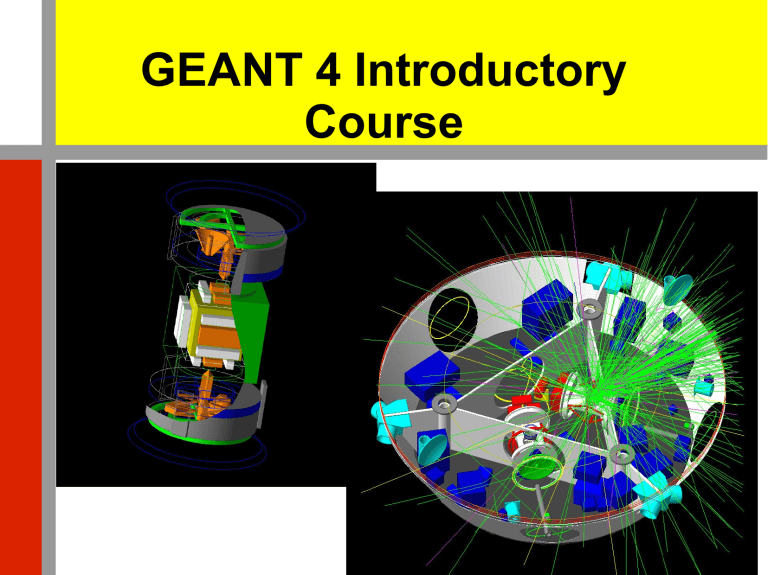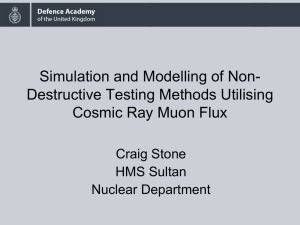GEANT 4 Introductory Course

GEANT 4 Introductory
Course
Outline
●
●
●
●
●
●
●
Why the Monte-Carlo approach
Basic GEANT4 concepts
A quick reminder of advanced C++
Defining materials and volumes
Defining detectors
Example: A trigger counter
Example: Raytracing in GEANT4
Why the Monte-Carlo approach
●
High-Energy Physics Detectors
–
–
– a particle interacts with the detector material, depositing energy (e.g. ionization)
● e.g. Landau distributed energy deposit → analog electrical signal
● noise, non-linearities of amplifiers, other statistical effects analog signal → digital signal
● noise, limited dynamic range semi-gaussian amplifier pulse
Simple Particle Detector:
Scintillator Counter p proton
10 GeV original signal shape
●
●
Consider a proton passing through a 10mm thick piece of scintillator
Energy deposit is Landau distributed
Simple Particle Detector:
Scintillator Counter noise effects blur original signal p proton
10 GeV
PMT
●
●
~25 photons detected by photomultiplier tube
Landau shape now convoluted with
Poisson distribution
Simple Physics Detector:
Scintillator Counter p proton
10 GeV limited dynamic range can create new features in spectrum
ADC PMT
●
● signal shape can be calculated convoluting half a dozen functions or using a Monte-Carlo method
Let's add some Complexity
●
●
●
What if we vary the angle of incidence?
Instead of one channel we have to consider between 10,000 channels (e.g. miniPEBS) and
10,000,000 channels (e.g. ATLAS, CMS)
We no longer have on physical process to worry about but several
–
–
–
–
– ionization energy loss cherekov radiation bending of track in magnetic field multiple scattering
...
The Advantages of Monte-
Carlo-Methods
●
●
We can break down a complex problem into many simple problems that are treated separately for a random initial state
–
–
– break down a long particle track into many small steps look at each detector component and each particle seperately treat physics processes consecutively instead of having to worry about everything at once
The output of our simulated detector is qualitatively the same as of the real detector
BUT BEWARE
●
●
●
A simulation will only produce what you put it
–
A simulation will help you understand your detector but it's a tool without scientific value by itself
Simulated detectors are based to a large part on
„Educated Guesses“
– Use set of parameters to be able to adjust your detector to match measurements.
Actually simulating all physical processes accurately is not possible
–
You have to make a lot of approximations: This WILL distort your results.
Basic GEANT4 Concepts
●
●
●
●
●
GEANT4 is a framework with an interface for integration in C++ programs
It does not offer a command-line interface or a
GUI to define the geometry
Every simulation is a compilable C++ program
The user supplies the geometry, the list of physics processes, the initial states
GEANT4 supplies the information about particles passing through user-defined inspection points called detectors
Basic GEANT4 Concepts
Under the hood
●
●
● break down particle track into small steps
– store particle momentum, positions before and after last step, polarization...
apply processes between steps
–
– processes may modify particle momentum, direction, polarization and/or create new particles processes may also modify current volume (e.g. store an energy deposit) newly created particles are also tracked some material some other material
Event Flow
●
●
●
●
Each event starts with a single created particle trakcing initial particle and all secondaries
After each event data for the particle trajectories can be accessed
GEANT4 allows intervening at any given point of the simulation
A quick Reminder of advanced C++
●
●
C++ allows for object-oriented software development and that is what we SHOULD do!
– this helps breaking down a software into convenient units called classes
– each component in your detector SHOULD be a class!
C++ provides a number of useful libraries
–
–
–
STL (map, vector, ...) for storing objects + useful algorithms for sorting, searching and copying objects
IOStream (fstream, sstream, ...) for reading/writing data
String (string) for character strings
Then there is ROOT
●
●
Data produced by
GEANT4 SHOULD be analyzed using ROOT
The data format of your
GEANT4 output
SHOULD match the one of the real detector
– you can write your readout/analysis software before your actual detector is working!
Use an Integrated
Development Environment
Using eclipse with GEANT4
●
●
● eclipse is an IDE
–
– editor with syntax highlighting and syntax checker advanced code browsing
CVS integration build process is entirely handled by eclipse
– no more Makefiles
Setting up GEANT4
●
●
●
●
Download & Install CLHEP (version 2.0.4.2)
● http://proj-clhep.web.cern.ch/proj-clhep/DISTRIBUTION/
Download & Install ROOT
● http://root.cern.ch/drupal/content/development-version-523
Download & Install GEANT4 (+ data files)
●
● http://geant4.web.cern.ch/geant4/support/download.shtml
GEANT4 requires a lot of options when installing – see next slide
Download & Install eclipse Ganymede for C/C++
●
● http://www.eclipse.org/downloads/
(or install eclipse CDT extension in your version of eclipse)
GEANT4 Install options
●
●
Run „Configure -build“ and set the following options
(for all others you can use the default)
●
●
●
●
●
●
●
Do you want to copy all Geant4 headers in one directory? [Y]
Do you want to build 'shared' (.so) libraries? [Y]
Do you want to build 'global' compound libraries? [Y]
Do you want to build 'granular' libraries too? [N]
Do you want to compile libraries in DEBUG mode (-g)? [Y] (you may switch this to NO later if your software runs to slowly)
Set G4UI_NONE/G4VIS_NONE environment variable? [N]
G4VIS_BUILD_OPENGLX_DRIVER / G4VIS_USE_OPENGLX
[Y]
Run „Configure -install“
Setting your system with
GEANT4
●
Set up your environment variables (e.g. adding the following lines to your ~/.bashrc file)
–
–
– source /path/to/geant4/.config/bin/Linux-g++/env.sh
export ROOTSYS=/usr/local export LD_LIBRARY_PATH=$LD_LIBRARY_PATH:
$ROOTSYS/lib
Setting up eclipse for
GEANT4
● eclipse requires list of GEANT4 libraries
–
– this is very tedious if you are using granular libraries
(GEANT4 then consists of 20+ libraries) all eclipse options for GEANT4 (and ROOT) are set in the
„geant4-sample“ project in the CVS
–
–
–
–
–
–
–
– in eclipse go to File→New→Project...
choose „CVS→Projects From CVS“, Next...
Choose „Create a new repository location“
Host: portal.physik.rwth-aachen.de
Repository Path:
/.automount/home/home__home4/institut_1b/amsana/Offline/CVS
User / Pass (your cluster login); Connection Type „ext“, Next...
Use an existing module (will list available modules) choose „geant4-sample“, Next..., Finish!
Defining Materials and
Volumes
G4Tubs.hh
●
●
●
●
The simulated detector geometry and materials are defined by a class extending
G4VUserDetectorConstruction
Use predefined volumes from
GEANT4
Each volume can have any number of sub-volumes of different materials
You can create unions & intersections of volumes
G4Box.hh
G4Sphere.hh
G4Torus.hh
G4Trap.hh
GEANT4 Geometry
Management
GEANT4: Defining Elements name under which element is stored
Z atomic weight
GEANT4: Defining Materials number of elements state of matter name of material density
# atoms per unit relative atomic abundance in material element to add
GEANT4: Defining Volumes define shape of volume by sub-class of G4VSolid return pointer to parent volume of whole detector define physical volume, setting position and orientation define logical volume, setting the material of the volume
Some words on Memory
Management
●
●
●
GEANT4 does not have any consistent memory management
For every class that you instantiate you will ultimately have to check whether GEANT4 cleans it up or whether you have to do it
– and no, it's not in the documentation handled by GEANT4
●
●
●
●
G4VSolids
G4VPhysicalVolumes
G4LogicalVolumes
...
● handled by user
●
●
●
●
G4Materials
G4MaterialPropertiesTables
G4Elements
...
Defining Detectors
●
●
●
GEANT4 provides a G4VSensitiveDetector class that should be extended to build a detector
G4VSensitiveDetector classes can be associated with (one or many) G4LogicalVolumes
GEANT4 will notify a G4VSensitiveDetector when a particle passes through associated Volume
GEANT4: Defining the
G4VSensitiveDetector initialize detector and the containers for the stored particle hits before each event interface to handle stored hits after each event called by G4SteppingManager to inform on particles
GEANT4: Creating the G4VHit store hit class holding infos about the particle offers access to current volume
You can obtain all kinds of information via the G4Step* interface
You can also do arbitrary changes to particle
GEANT4: Accessing stored hits at the end of event
●
Extend G4UserEventAction to access the event data interface of G4UserEventAction access stored hits via G4Event*
Example: A Trigger Counter
●
●
●
Let's look at our first
GEANT4 program
Simulate a Trigger counter made up of Polystyrene
–
40mm x 400mm x 10mm in size
Question: How much energy does a muon deposit in the Scintillator?
–
– isotropic incidence
1 GeV momentum
GEANT4: PhysicsList all the physics we need for muons
GEANT4:
PrimaryGeneratorAction
G4ParticleGun produces primary particles. We load it with a µ-
Set initial position of particle
Set direction of particle
Set energy and fire away
int main(int argc, char** argv)
G4RunManager is the backend of the simulation framework
Definition of
Geomety
Physics
Definition
Set initial state
Our own
EventAction
Class used for readout some initalization
int main(int argc, char** argv)
Run Simulation
Start GEANT4 command shell cleanup
The Result: Energy left by a µ in 1cm scintillator
Example: Raytracing in
GEANT4
●
●
●
Next up: Add Photons
GEANT4 knows about scintillation and optical processes
Use this to determine how many photons can be detected reading out scintillator with PMT
–
–
– quantum efficiency 20% borosilicate glass cathode of PMT
(5cm diameter) reflective coating of scintillator
(reflectivity 92%)
GEANT4: New PhysicsList -
OpticalPhysics this is all it takes to define a new particle
GEANT4: New PhysicsList -
OpticalPhysics construct the scintillation process add scintillation process to all particles that it is applicable to add optical physics processes to photons
(absorption/reflection
/refraction/scattering)
GEANT4 Geometry
Management
GEANT4: Optical Properties of Materials
G4MaterialPropertiesTable holds all optical properties
(and so far ONLY optical properties) define abs. length to enable absorption process in material optical photons cannot enter any materials without valid refractive index
GEANT4: Optical Surfaces
G4OpticalSurface holds surface properties
G4LogicalBorderSurface associates interface between
two physical volumes with G4OpticalSurface
Result: # Photons from
Scintillator
Excercise:
●
Let's assume we did not have a large PMT for readout but a 3mm x 3mm silicon photomultiplier with a quantum efficiency of 50%
–
–
How many photons would you detect with such a SiPM?
What time resolution would you achieve with that number of photons assuming that you can measure the time the first photon hits the SiPM?
●
●
●
GEANT4 keeps track of the time for each G4Step it calculates
To determine the time resolution, you have to keep track of the point where the primary particle passes through your scintillator
The simulation is very slow. You should parallelize your efforts and have GEANT4 continuously write 'out the latest event

